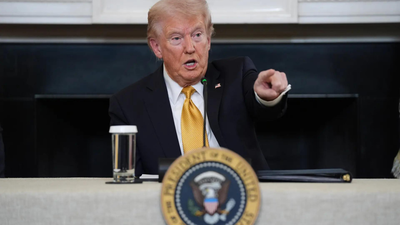US President Donald Trump embarked on his first Asia tour of his second term on Saturday, seeking to restore economic balance and reaffirm Washington’s influence in a region strained by tariffs and shifting alliances. The week-long trip will take him through Malaysia, Japan, and South Korea, with a long-anticipated meeting with Chinese President Xi Jinping on the final leg.Speaking aboard Air Force One, Trump said he expected a “very good meeting” with Xi, signalling optimism that both sides could reach a deal to avoid the 100 percent tariffs due to take effect on November 1. The meeting, slated to take place during the APEC summit in South Korea, could either ease global economic tensions or ignite another round of trade confrontation.
The 47th POTUS also hinted he might meet North Korean leader Kim Jong Un for the first time since 2019, saying, “I had a great relationship with him… I’m open to it.” South Korean officials have described a Trump–Kim meeting as “considerably likely,” particularly during the APEC gathering.Trump’s Asia itinerary includes signing new trade deals, overseeing a peace accord, and pressing key allies for fresh investment commitments — all while trying to balance his “America First” tariff agenda with renewed diplomatic engagement.
Malaysia Summit: Peace deal and economic outreach
Trump’s first stop is Malaysia, where he will attend the Asean summit — a forum he avoided for much of his first term. He is set to preside over a peace agreement between Thailand and Cambodia, ending months of deadly border clashes, and to witness East Timor’s formal induction as Asean’s 11th member.The visit also comes amid heightened security in Kuala Lumpur, with protests planned over Trump’s stance on the Middle East. Malaysian Prime Minister Anwar Ibrahim said demonstrations would be permitted but promised “smooth proceedings” for the summit.Anwar acknowledged criticism of Trump but praised his role in brokering a Gaza ceasefire. “It’s an important step forward,” Anwar said, though he insisted Malaysia would still raise the Palestinian question during talks.Asean leaders, meanwhile, will focus on regional stability and economic resilience as the bloc faces pressures from global trade realignments. Malaysia’s foreign minister warned that “the turbulence of global politics” was shrinking Asean’s space for neutrality in trade and security.
Tokyo talks: Japan’s new leader and the $550 billion question
From Kuala Lumpur, Trump will head to Tokyo to meet Japan’s newly elected Prime Minister, Sanae Takaichi — the country’s first female leader. Takaichi, a protégé of the late Shinzo Abe, has pledged to maintain close security ties with Washington but faces pressure at home to ensure Japan’s interests are protected under Trump’s aggressive tariff regime.At stake is a massive $550 billion investment package Japan pledged to inject into the US economy, which earned it relief from harsher tariffs earlier this year. But Tokyo remains wary of Washington’s trade terms and wants greater control over how the funds are deployed.Takaichi also intends to seek assurances that the US will continue to uphold its military alliance with Japan amid growing Chinese assertiveness in the region. She has pledged to increase defence spending to 2% of GDP — two years ahead of schedule — signalling Japan’s readiness to play a more active regional role.
South Korea: Tariffs, tech, and the Xi summit
The final leg of Trump’s trip takes him to South Korea, where he will attend the APEC summit in Gyeongju and hold his much-anticipated meeting with Xi. Global markets will be watching closely as both leaders attempt to navigate the escalating trade war.Beijing is expected to push for the removal of US export controls and technology restrictions, while Washington seeks greater Chinese purchases of American goods, including soybeans and Boeing aircraft. The talks come after months of tariff brinkmanship, further complicated by Beijing’s restrictions on rare-earth exports critical to global manufacturing.Trump’s meeting with South Korean President Lee Jae Myung will also focus on resolving a $350 billion investment dispute that has stalled since July. Seoul faces pressure to finalise the deal while protecting its auto industry, currently hit by a 25% tariff.“The biggest gamble of Trump’s second term,” said former strategist Steve Bannon, “is whether he can turn confrontation with China into an economic victory.”Analysts expect any Trump–Xi understanding to be limited — perhaps an extension of the summer’s trade truce — allowing negotiators more time to finalise details. But the symbolism alone could serve Trump’s political aims, projecting him as a dealmaker amid global uncertainty.Trump’s Asia tour is as much about optics as substance. Between trade talks, peace deals, and potential meetings with Kim, the president aims to project strength abroad while his administration faces domestic pressure over tariffs and inflation, and the government shutdown. Go to Source



